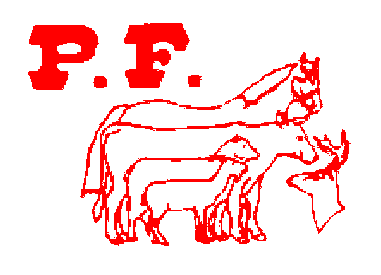Frequently Asked Questions
What consumption levels should I expect on my cows when I supplement with PF tubs?
Average range conditions require approximately ½ to 1 pound per animal daily. Weather does not adversely affect the product. Adequate forage must be available at all times. Winter consumption will be slightly higher.
How many tubs should I put out for my cows and where?
Provide one tub for each 6-8 head of cattle. Place the tub for easy consumption.
If I run my cattle and horses together – which product should I use?
The All-Natural 18% – this is for all livestock species.
Will it pay to supplement year-around?
Yes! See Supplemental Effects under Comparisons and Testimonials. You will see the cost benefits!
What makes your tub different from the other low-moisture products?
PF supplements are manufactured with a patented ingredient process (#4,749,578) which makes a harder and more consistent product! Though many companies have tried throughout the years to copy or overcome market share, they have yet – to out do us!
Frequently Asked Questions About IGR.
Why worry about controlling horn flies more than other flies?
The horn fly is one of the most important and economically damaging pests of range cattle. In the United States they cost cattle producers approximately $876 million every year. This is more than the economic damage infected by face flies, houseflies and stable flies combined. In addition, damage caused by horn flies exceeds the combined animal cost of Bovine Respiratory Disease and Coccidiosis. Horn fly infestations can reduce weaning weights by 10 to 25 pounds per calf, reduce growth rates in replacements heifers 13 to 14% and reduce daily gains in yearlings and stockers by 0.2 pounds per day. Milk production can reduce by 10 to 20%.
How does IGR feed thru work?
The IGR passes through the cows’ digestive system and resides in the manure, where the horn flies lay their eggs. The IGR mimics the presence of natural Juvenile hormones and prevents the horn fly from emerging from the pupae stage to the harmful adult stage.
Will IGR Feed thru kill adult Horn Flies?
NO, its mode of action inhibits the development of horn flies in cattle manure, stopping fly development in the pupae stage before they mature into harmful adults.
How is IGR Feed thru available?
It is available in mineral, blocks, tubs and a premix that can be top dressed or mixed into feed.
When should IGR feed thru be fed to control horn flies?
Thirty days prior to the horn fly season through 30 days after the first frost.
If I use IGR feed thru in my mineral program and my neighbors don’t, can I still obtain good horn fly control?
Horn flies, although not strong fliers, will migrate between herds. Common watering areas, fence lines, areas where cattle congregate and cattle pastured on small acreages tend to aggravate the situation. Cattle treated with IGR Feed thru will have fewer flies in these situations than untreated animals.
Does IGR feed thru harm dung beetles and other beneficial insects?
The level of IGR feed thru found in the manure of treated cattle when used according to label directions has no effect on dung beetles and other beneficial insects.
Can horn flies become resistant to IGR feed thru?
NO, there has not been a verified case of resistance to Methoprene since the technology was introduced in 1975.
Will IGR Feed thru harm horses?
Horses have been experimentally dosed with Methoprene without adverse clinical signs or loss of appetite.
Should I worry about horn flies in feedlot cattle or in a dairy where cows are kept in barns or dry lots?
No, horn flies and face flies are range or pasture pests and rarely do they become pests of livestock in confined areas.
Should I be concerned about exposing my family and employees to pesticide products?
Pesticides should be used according to label directions. IGR products exhibit a wide margin of safety and no acute handling hazard by any exposure route.
What does it cost me to treat my cattle with IGR feed thru?
IGR usually costs $.03 to $.05 per day. When all cost of treating with other insecticide applications are considered it is very comparably priced. For example with pour-on’s costs of shrink, depreciation of equipment, time and labor must be combined into the price of application

